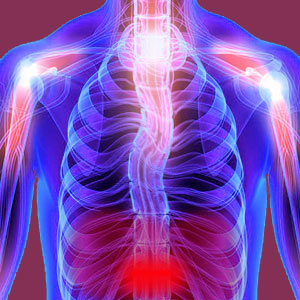
Thoracic scoliosis is wholly contained within the upper and middle back region. Thoracic side to side spinal curvatures are some of the most common forms of scoliosis. Exclusively thoracic curvatures are slightly more prevalent than some forms of scoliosis, such as thoracolumbar, but are seen exponentially more often than cervical scoliosis and even cervicothoracic scoliosis.
The thoracic spine is the most active scoliosis zone in the human backbone. However, many curvatures here also affect neighboring spinal regions, such as the cervical and/or lumbar sectors. Regardless, some patients demonstrate curvatures that fully exist within the boundaries of the thoracic spine. This essay explores thoracic side to side spinal curvatures and answers questions posed by many patients who are affected by this rather typical scoliotic profile.
Thoracic Scoliosis Anatomy
The thoracic spine is the largest and longest region of the human vertebral column, containing 12 individual vertebral bones and 12 intervertebral discs. The thoracic levels also feature the rib cage, inside which are contained the various internal organs that are so critical to our functionality as healthy humans.
Scoliosis that resides wholly within the thoracic spine can be C shaped or S shaped, as the region is large and allows much freedom for the curvature to develop. The apex of the curvature is usually near the frontier between middle and upper back (T6/T7), although it can exist elsewhere.
Severe thoracic curvatures can be troublesome, as they express large angles of curvature in a relatively small anatomical space, potentially encroaching on the internal organs. Common side effects of very significant thoracic curvature include compression of the heart and/or lungs and limited breathing capacity, possibly necessitating invasive surgical treatment. Other less common collateral effects include infringement on other bodily organs which can influence digestion or overall systemic functionality.
Thoracic Spinal Curvature Occurrence
Thoracic region-specific scoliosis is far more common than cervical, cervicothoracic and cervicothoracolumbar scoliosis. However, it is just a bit more prevalent than common thoracolumbar curvatures.
Distribution of affected patients ranges greatly, with some patients being adult, while others are affected congenitally, during early developmental periods or during adolescence. Causative factors and contributors to thoracic specific scoliosis include hemivertebra formations, rib abnormalities, kyphosis abnormalities, injury and post-surgical trauma. Degenerative-induced thoracic scoliosis is very rare, since the upper and middle back zones do not generally experience the type or degree of structural deterioration that plagues the remainder of the spinal levels.
Thoracic Scoliosis Overview
Most thoracic scoliosis is related to the kyphotic curvature of the upper back. In some cases, hyperkyphosis or hypokyphosis will incite the scoliosis, causing a side to side curvature in reaction to exaggerated or deficient front to back curvature, most typically in association with vertebral rotation. In other cases, the scoliosis can affect the kyphosis, causing an increase or decrease in its typical degree of front to back curvature.
Statistically, C shaped curvatures in the thoracic spine are more symptomatic than S shaped curves. C shaped curvatures are also more visually and clinically significant and might unbalance the spinal column at crucial locations.
We always suggest seeking expert level care from a specialist in thoracic side to side curvature for best results regarding diagnostic accuracy and treatment efficacy.
Scoliosis > Side to Side Spinal Curvature > Thoracic Scoliosis





